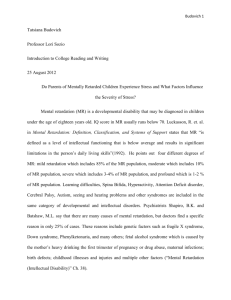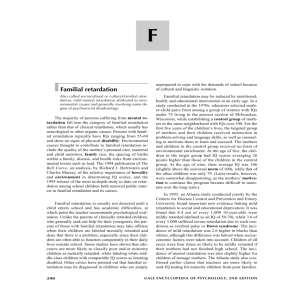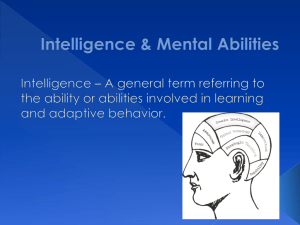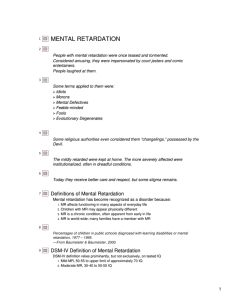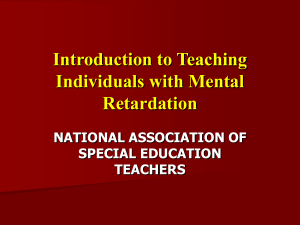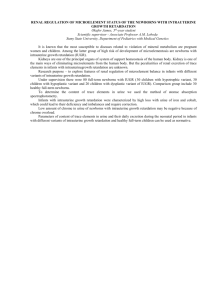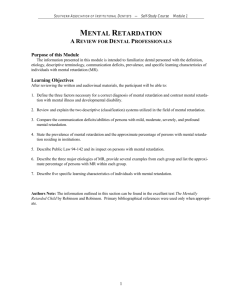A1989U520800001
advertisement
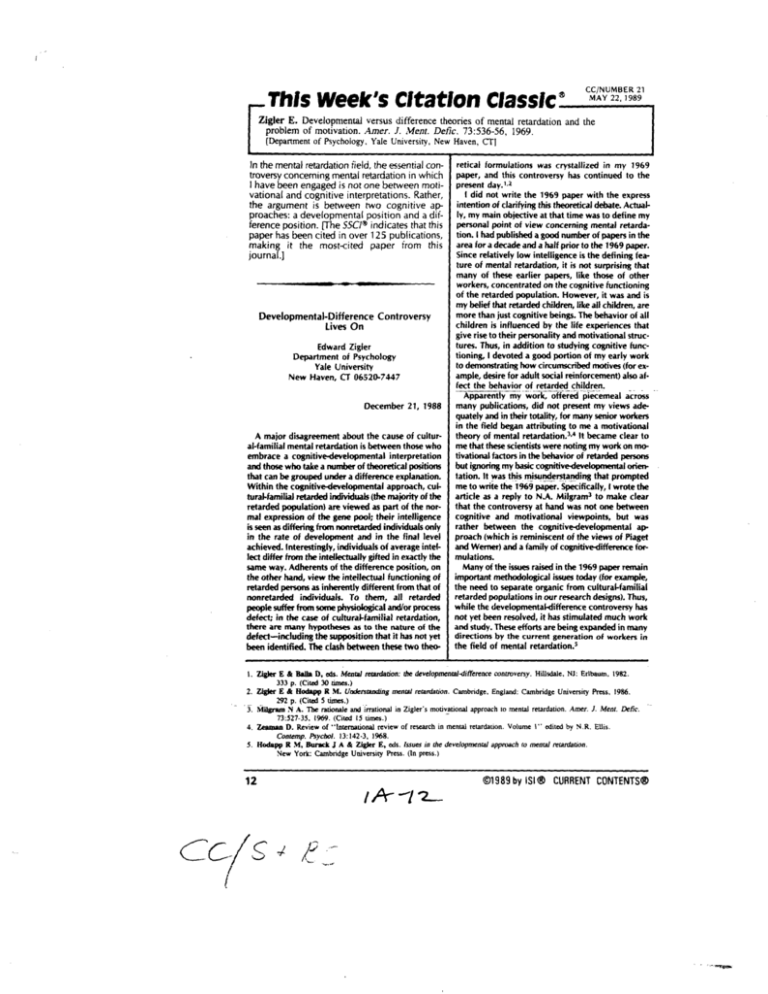
~.ThlsWeek’s Citation C1ass1c~__CC~UMBER21 Zigler E. Developmental versus difference theories of mental retardation and the problem of motivation. Amer. J. Mont. Defic. 73:536-56, 1969. [Department of Psychology, Yale University, New Haven, CTI In the mental retardation field, the essential controversy concerning mental retardation in which I have been engaged is not one between motivational and cognitive interpretations. Rather, the argument is between two cognitive approaches: a developmental position and a difference position. [The SSCI® indicates that this paper has been cited in over 125 publications, making it the most-cited paper from this journal.1 Developmental-Difference Controversy Lives On Edward Zigler Department of Psychology Yale University New Haven, CT 06520-7447 December 21, 1988 A major disagreement about the cause of cultural-familial mental retardation is between thosewho embrace a cognitive-developmental interpretation and those who take a number oftheoretical positions that can be grouped under a difference explanation. Within the cognitive-developmental approach, cultural-familial retarded individuals(the majority of the retarded population) are viewed as part of the normal expression of the gene pool; their intelligence is seen as differing from nonretarded individuals only in the rate of development and in the final level achieved. Interestingly,individuals of average intellect differ from the intellectually gifted in exactly the same way. Adherents of the difference position, on the other hand, view the intellectual functioning of retarded persons as inherently different from that of nonretarded individuals. To them, all retarded people sufferfrom some physiological and/or process defect; in the case of cultural-familial retardation, there are many hypotheses as to the nature of the defect—including the supposition that it has not yet been identified. The clash between these two theo- retical formulations was crystallized in my 1969 paper, and this 2 controversy has continued to the present day.” I did not write the 1969 paper with the express 1intention of clarifying this theoreticaldebate. Actualy, my main objective at that time was to define my personal point of view concerning mental retardation. I had published a good number ofpapers in the area for a decade and a half prior to the 1969 paper. Since relatively low intelligence is the defining feature of mental retardation, it is not surprising that many of these earlier papers, like those of other workers, concentrated on the cognitive functioning of the retarded population. However, it was and is my belief that retarded children, likeall children, are more than just cognitive beings. The behavior of all children is influenced by the life experiences that give rise totheir personality and motivational structures. Thus, in addition to studying cognitive functioning, I devoteda good portion of my early work to demonstrating how circumscribed motives (for example, desire for adult social reinforcement) also af. feet the behavior of retarded children. - ~A~~iently my work, offered piecemeal across many publications, did not present my views adequately and in their totality, for many senior workers in the field began attributing3to 4 me a motivational theory of mental retardation. - It became clear to me that these scientists were noting my work on metivational factors in the behavior of retarded persons but ignoring my basic cognitive-developmental orientation. It was this misunderstanding that prompted me to write the 1969 paper. Specifically, I wrote the 3 article as a reply to MA. Milgram to make clear that the controversy at hand was not one between cognitive and motivational viewpoints, but was rather between the cognitive-developmental approach (which is reminiscent of the views of Piaget and Werner) and a family of cognitive-difference formulations. Many of the issues raised in the 1969 paper remain important methodological issues today (for example, the need to separate organic from cultural-familial retarded populations in our research designs).Thus, whilethe developmental-difference controversy has not yet been resolved, it has stimulated much work and study. These efforts are being expanded in many directions by the current generation of workers in 5 the field of mental retardation. I. Zigkr E & flaIls 0, eta. Mental retardation: the developmental-difference controversy. Hilisdale. NJ: Erlbaurn. 1952. 333 p. (Cited 30 dInes.) 2. Zlgkr E & Hodapp R M. Usxierstanding mental recaadation. cambndge. England: Cambridge (Jmversity Press, 1956. 292 p. (Cited 5 times.) 3. MiIgr~mN A. The rationale and irrational in Zigler’s motivational approach to mental retardation. Amer. J. Men!. Del)c. 73:527-35. 1969. (Cited 15 times.) 4. Zeaman 0. P,eview of “International review of research in mental retardation. Volume I” edited by N.R. Ellis. Coazemp, Psycho). 13:142-3, 196$. 5. Hodapp R M, Burack J A & Zigler E, eels. tssues in the developmental approach ta mental ma.rdation. New York: Cambrtdge University Press. (In press.) 12 t~1989by SI® CURRENT CONTENTS® ~
